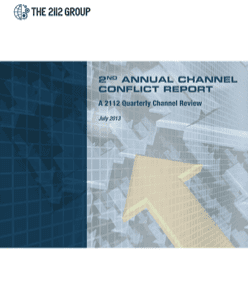Topics
Chasing The Elusive Return On Channel Investment (ROCI)
 By Jim Somers, Relayware
By Jim Somers, Relayware
As summer begins to wind down, many of us kick into gear with that dreaded annual exercise: Budget planning. (Group groan) If you’re an experienced channel executive, you know the channel budgeting process can be arduous and downright painful at times, especially if your CFO calls you to the mat to show a return on last year’s investment. (“Hey Mike. How much revenue did that $5 million budget generate for us this year? Looking back, would you have allocated it any differently? Which program investment paid the highest dividends for us? ”)
Channel executives have myriad investment options to choose from — a virtual control panel of program dials and levers, such as partner recruitment, training, sales enablement, marketing, MDF, rebates, incentives and many others. Rarely does one allocate funds equally across all their programs since some programs may be deemed to be more impactful, resulting in more partner-generated revenue or engendering greater partner loyalty. Some programs may either be immature and need propping up, while others could just be underperforming and need more investment dollars.
It is at this more granular interdependent partner program level where Return on Channel Investment (ROCI) is measured and optimized.
In order to run properly, your partner program engine needs the right resources:
- People: Internal staff and external contractors in sales, marketing and operational roles;
- Content: White papers, collateral, training videos, tutorials and research reports; and
- Technology: Partnering automation systems for partner program support and operations management.
Where To Invest: People Or Technology?
As you begin to chart out your channel budget and plan for next year, one of the first decisions you’ll need to make is how much to invest in people and the technology to support them. This decision often depends on the maturity of your channel processes; is it a process we do well and can benefit from greater efficiency, or it is something new that requires certain expertise?
For example, if your on-boarding and training programs are mature and proven, but are mostly done in a classroom setting, perhaps automating the training process could increase your effectiveness without having to add more people (e.g., trainers). Channel processes that rely mostly on people to manage them frequently start to crumble at the 75- to 100-partner mark. As your internal channel team’s effectiveness slows, your partners’ satisfaction and loyalty could start to suffer. So it’s important to know when to slow the hiring process, and when to augment your channel program with partnering automation to handle more of the mundane tasks.
At this juncture you should examine your technology priorities. Do you have a partner portal? Can your partners effortlessly register their deals anywhere anytime? Is it time to systematize co-branding marketing materials?
All Investments Should Lead To Revenue (And Cost Reduction)
Investments are intended to produce returns. In the case of channel investments, those returns are measured in terms of:
- Higher partner-generated revenue
- Lower partner program costs
Some programs are so closely tied to revenue it makes measuring ROI more straightforward. For example, the number of deals your partners register can be directly correlated to the number of closed deals.
For others, you need to build a dependency chain model. Consider a partner marketing concierge service where the partners can call in with their marketing questions. With a dependency chain model it is clear that as long as the cost of a marketing concierge service is less than the investment in the service and results in greater incremental partner-generated revenue, this is a wise investment. But you’ll need to bring together the disparate costs of both scenarios to clearly see the costs or benefits.
Longer-Term Channel Investments And Payoffs
Some channel investment returns cannot be measured in a single year, much less a quarter. For instance, training programs take time, typically years, to develop, implement, measure and refine. Same with marketing development funds (MDF), which also can have a long gestation period before returns start coming in. So, as you are contemplating your program investments, it’s important that you take into account the appropriate timeline for seeing a return on that investment.
Partners’ loyalty significantly factors into ROCI. Smaller partners can only afford to have relationships with very few vendors, and therefore, you have more of their mindshare and loyalty. However, as a partner gets bigger, they add vendors to their portfolio. And the battle for that partner’s loyalty (i.e., your wallet share) begins. Nonetheless, a small wallet share of a large partner can represent more revenue, by an order of magnitude, than a larger share of a small partner. So building and maintaining partners’ loyalty is critical. Lose their loyalty and you lose that revenue, future revenue and market share.
Partners’ loyalty is not easily replaced. Lost partner loyalty means not only losing the investment in developing that partner, but also you will have to invest in recruiting new partners. This is quite costly compared to maintaining your top partners’ loyalty.
The ROCI Of Incentive Programs
The ROCI of incentive programs is nearly impossible to determine. The effect (increased revenue) may or may not be directly connected to the cause (the incentive). While incentives have some effect on boosting revenue, there may be other parallel factors, such as newly certified partners, a marketing concierge program, positive press/analyst coverage, macroeconomic factors, etc.
Also look at how many of your eligible partners participate in your incentive programs. Partners often say that vendors’ incentive programs are “too many, too complex” and ignore many of them. Do you need to reduce or simplify your incentive programs to lead to higher ROCI? If you run 10 simple incentive programs per year, instead of 20 complex programs, you may be able to get 75% participation, as opposed to 50% participation. Often these are tactical programs, which garner not only revenue momentum but also partner loyalty. Also, know what your competitors are offering partners to take into account the whole program value.
Channel Investment Portfolio And ROCI Strategies: Different Strokes For Different Folks
In summary, there are many partner program options and investments, and they are inter-related. Early in your channel program’s life, have a more aggressive investment strategy, one that pays the highest returns in a relatively short amount of time. More channel-mature vendors should adopt a longer-term ROCI strategy.
Chart out your program as it stands this year. Then, map out the next immediate needs, including costs and expected returns. Go a step farther, and see where the longer-term needs will be, and put those costs and returns against a timeline. Make sure your marketing, sales and operations teams are seeing the same picture of the current channel program situation and begin the dialog about next immediate needs. Even if you don’t immediately agree, this conversation will create a smoother road ahead as the program grows. Further, ensure your C-Suite executives also understand your channel program’s costs and returns of each element.
Below are high-level guidelines to help you determine your stage of maturity and where to go next:
Best short-term partner program investment options:
- Partner recruitment
- Deal registration
- Incentive programs
Best medium-term:
- Partner support and concierge services
- Partner training & certification
- Events
- NFR products
Best long-term
- Partner loyalty
- MDF
- Partner showcasing and marketing materials
Jim Somers is Chief Marketing Officer at Relayware. With more than 15 years of experience in SaaS technology, marketing automation, mobile apps and cloud collaboration, Jim currently leads the company’s global marketing strategy — overseeing demand generation, product marketing, global communications, and corporate branding efforts. Prior to joining Relayware, Jim spent over a decade in the mobile industry heading up marketing for Antenna Software (acquired by NASDAQ: PEGA) and Fiberlink Communications (acquired by NYSE: IBM). Prior to his time in mobile, Jim was Director of Marketing Services for Responsys (acquired by NYSE: ORCL) where he established the company’s marketing consulting practice. Jim started his career in advertising as an Account Executive for Ogilvy & Mather and Lintas Worldwide, and worked for AT&T as a Marketing Director in their Consumer division.














